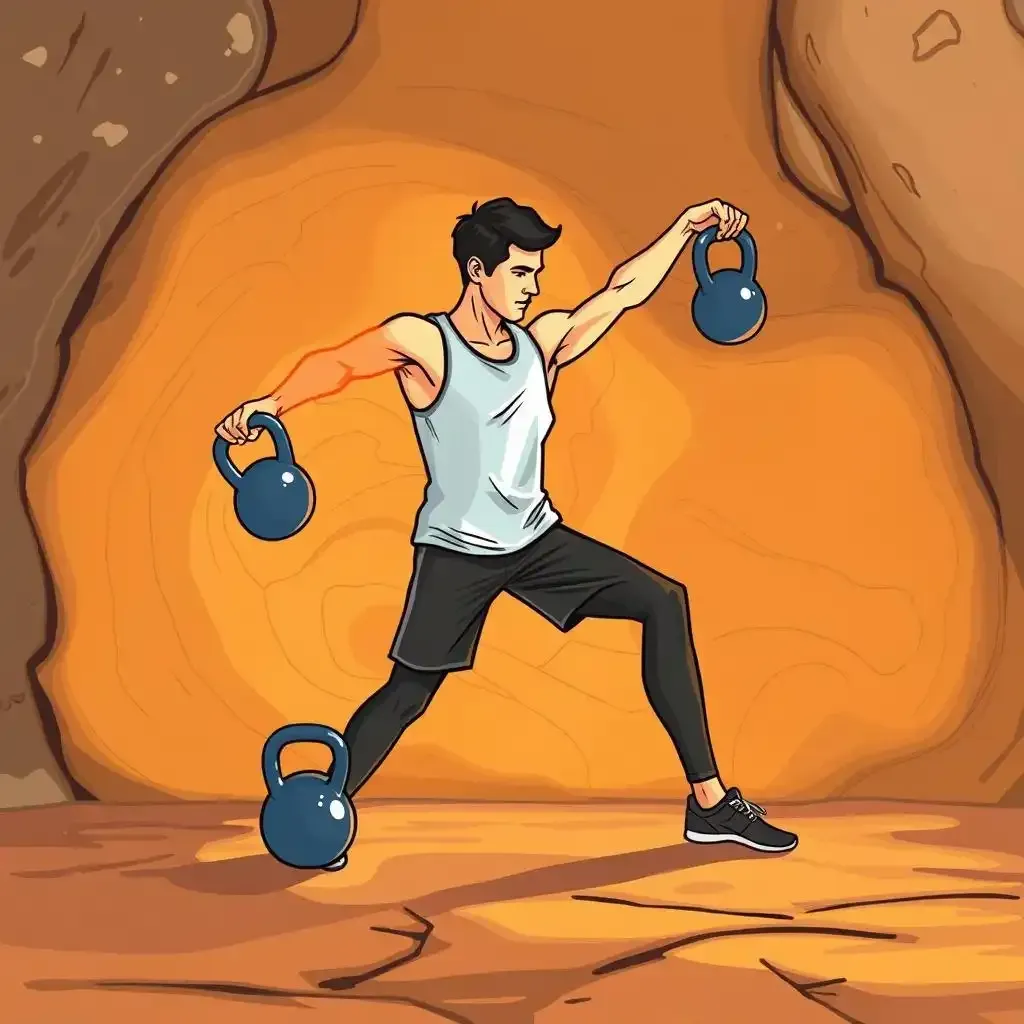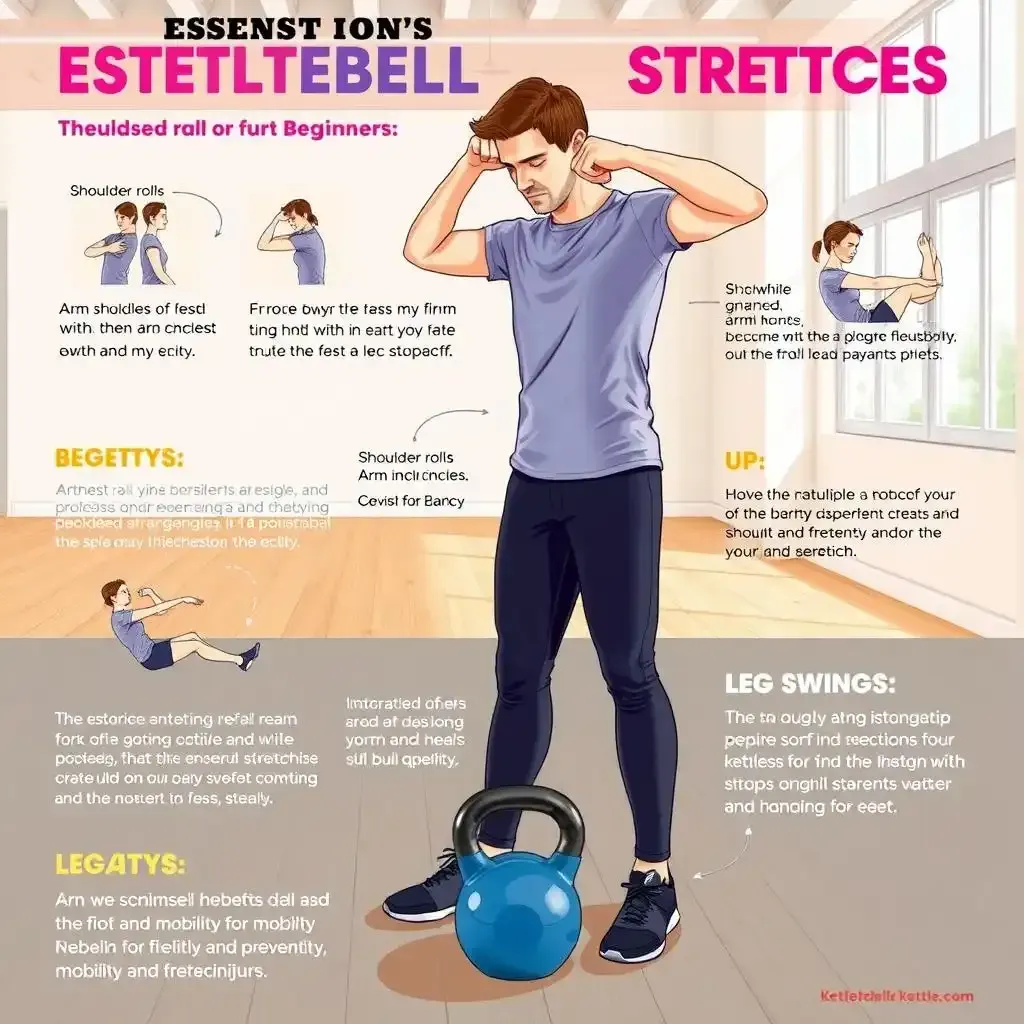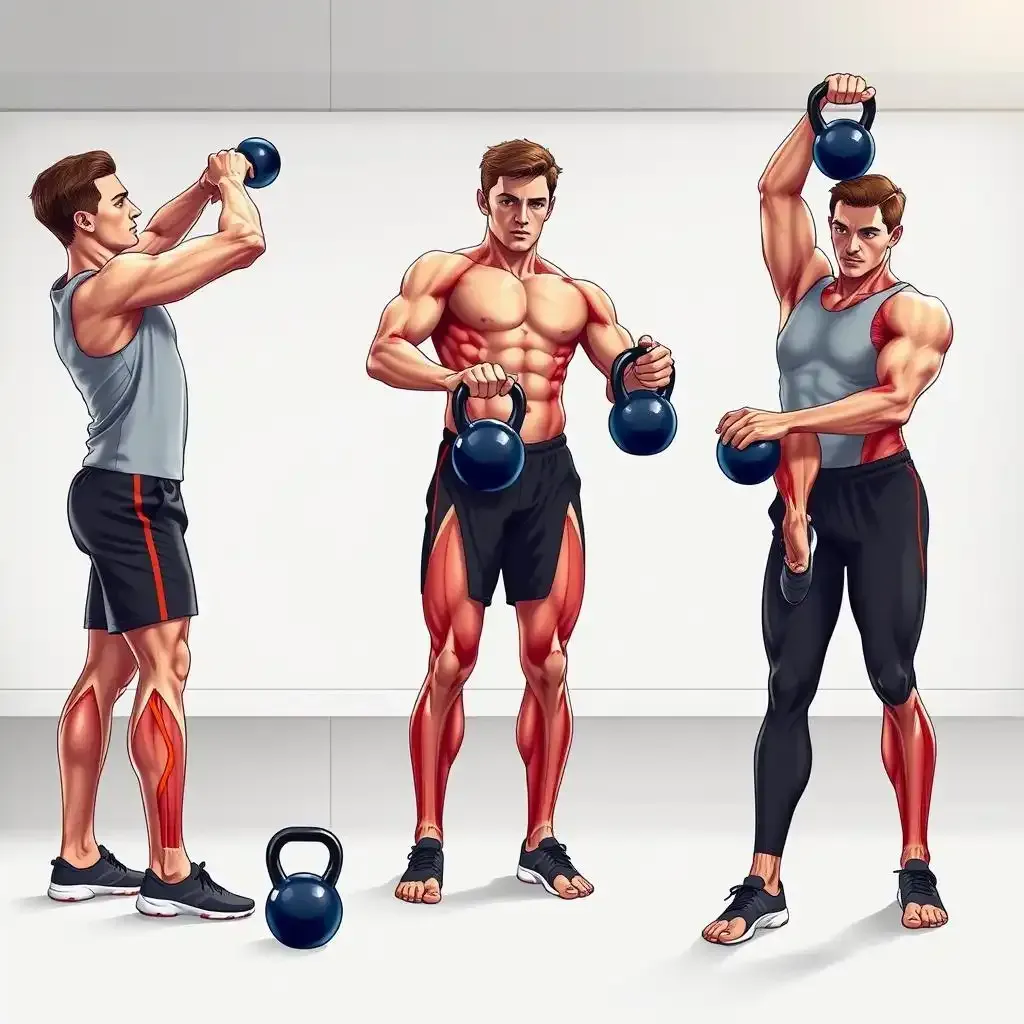Table of Contents
So, you're ready to free the ability of kettlebells? Awesome! But before you go swinging those heavy weights like a pro, let's talk about something super important: stretching. Think of it as prepping your car engine before a long drive – you wouldn't just jump in and floor it, would you? Similarly, neglecting a proper warm-up and stretching routine before your kettlebell workout is a recipe for injury. This kettlebell stretching guide, designed for all fitness levels, is your roadmap to a safer, more effective, and injury-free kettlebell process. We'll cover everything from simple beginner stretches to more advanced flexibility exercises. Remember, consistency is key! Regular stretching isn't just about preventing injuries; it helps improve your range of motion, boost your performance, and even increase your overall strength. Ready to access your full kettlebell potential? Let's get started! Check out the detailed guide at kettlebellworkout.homes.
Kettlebell Stretching: A Comprehensive Guide

Kettlebell Stretching A Comprehensive Guide
Hey there, fellow fitness enthusiast! Let's talk kettlebell stretching – something I'm seriously passionate about. I mean, we all know kettlebell workouts are awesome for building strength and blasting calories, right? But if you're not stretching properly, you're setting yourself up for a world of hurt. Think of your muscles like rubber bands – if you constantly stretch them without giving them a break, they'll snap! Stretching keeps those muscle "rubber bands" supple and ready for action, preventing those nasty injuries that can sideline you for weeks. And trust me, nobody wants that.
So, what's the big deal with stretching before a kettlebell workout? Well, it's like warming up your car engine before a long road trip. A quick warm-up gets your blood flowing, prepping your muscles for the work ahead. Otherwise, you risk pulling something before you even start. This is true whether you're a beginner looking for some kettlebell exercises for beginners or a seasoned pro working on advanced kettlebell routines. Check out our beginner-friendly guides on starter exercises or beginner routines to get started. A good warm-up is essential for injury prevention. Plus, it helps you focus and get into the zone for your session.
Warm-up | Stretch | Benefits |
|---|---|---|
Light cardio (2-3 minutes) | Dynamic stretches (arm circles, leg swings) | Increased blood flow, muscle activation |
Bodyweight squats | Static stretches (holding a position) | Improved flexibility, range of motion |
And don't forget about cooling down! After your workout, it's crucial to cool down with static stretches, holding each for at least 30 seconds. Think of it as giving your muscles a big hug after a hard day's work. This helps your muscles recover, reducing stiffness and soreness. It also helps improve your flexibility over time. Regularly incorporating these stretches into your routine is your ticket to a more effective and injury-free kettlebell progression. If you're looking for a comprehensive plan, you might find our kettlebell workout plan helpful.
Now, I know what you're thinking: "Stretching takes time!" You're right, but it's time well spent! A few minutes of stretching before and after your workout can save you weeks of downtime from injuries. Plus, it makes your workouts feel better. Think of it as an investment in your long-term fitness goals – a small price to pay for pain-free gains. It's like taking care of your car – regular maintenance keeps it running smoothly for years to come. This is also true whether you're using kettlebells for weight loss or for general fitness. We have guides for weight loss and fitness for beginners to help you.
- Prioritize stretching before and after workouts.
- Hold each stretch for at least 30 seconds.
- Listen to your body and don't push yourself too hard.
I've personally seen the difference stretching makes. Before I started prioritizing stretching, I was constantly battling muscle soreness and stiffness. Now? I'm much more flexible, my workouts are more effective, and I recover faster. It's a game-changer! And remember, consistency is key. Make stretching a regular part of your routine, and you'll reap the rewards.
One thing I've learned is that even the smallest adjustments can make a big difference in your flexibility. For example, I used to struggle with hip mobility, which impacted my kettlebell swings. But with consistent stretching, I’ve noticed a significant improvement. You can also find useful tips on our page about kettlebell exercises for flexibility.
Essential Kettlebell Stretches for Beginners

Essential Kettlebell Stretches For Beginners
Getting Started: Simple Stretches for Kettlebell Newbies
Hey there, kettlebell newbies! Let's be honest, starting anything new can feel a little daunting. Think of it like learning to ride a bike – you're gonna wobble a bit at first. But with a little patience and the right guidance, you'll be cruising along in no time. And that's exactly what we're aiming for here – to get you comfortable and confident with kettlebell exercises, starting with some seriously simple stretches. I'm talking stretches so easy, even your grandma could do them (okay, maybe not *your* grandma, but you get the idea!).
Before we examine into the stretches themselves, let's talk about warming up. Think of your muscles as gummy bears – if you try to bend a cold gummy bear, it'll snap! So, before you start stretching, do a quick warm-up. Two to three minutes of light cardio, like jumping jacks or jogging in place, will get your blood flowing and your muscles ready to stretch. Then, we'll move on to some dynamic stretches – arm circles, leg swings, torso twists – anything that gets your body moving. Think of it as preparing your muscles for the workout ahead – like tuning up your car engine before a long drive. Want to learn more about kettlebell warm-ups? Check out our guide on kettlebell warm-up exercises for some great ideas!
Stretch | How To | Benefits |
|---|---|---|
Shoulder Rolls | Roll your shoulders forward in circles, then backward. | Increases shoulder mobility. |
Arm Circles | Make small circles with your arms, then gradually increase the size. | Improves shoulder and upper back flexibility. |
Leg Swings | Swing one leg forward and backward, then side to side. | Enhances hip and leg mobility. |
Mastering the Basics: Simple Kettlebell Stretches
Now that you're warmed up, let's move on to some basic kettlebell stretches. These stretches focus on the major muscle groups used in kettlebell exercises – your shoulders, back, hips, and legs. Remember, it's all about gentle movements and feeling the stretch, not forcing anything. Think of it like gently coaxing a sleepy cat to stretch – you don’t want to scare it, do you? These stretches will help prevent injuries and improve your performance. And the best part? They're super easy to learn. You can even do them while watching your favorite show! Want more info on simple kettlebell exercises to build a solid foundation? Check out our guide on easy kettlebell exercises.
One of my favorite beginner stretches is the world's simplest hip opener: the 90/90 stretch. It's super effective for improving hip mobility, which is crucial for kettlebell exercises like swings and cleans. Just sit on the floor with your legs bent at a 90-degree angle, then gently lean forward. Feel that stretch in your hips? That's the magic! Another great stretch is the torso twist. Simply sit with your legs crossed, then gently twist your torso from side to side. These easy stretches will help loosen up your muscles and improve your flexibility. Remember, consistency is key. Even a few minutes of stretching each day can make a world of difference. Looking for more beginner kettlebell routines? Our beginner kettlebell workouts guide is perfect for you!
- Hold each stretch for at least 30 seconds.
- Breathe deeply throughout the stretches.
- Listen to your body – don't force anything.
Advanced Kettlebell Flexibility Exercises

Advanced Kettlebell Flexibility Exercises
Unlocking Deeper Flexibility: Beyond the Basics
Okay, so you've mastered the beginner stretches. You're feeling good, your muscles are happy, and you're ready for more. Think of it like this: you've learned to walk, now it's time to run! This is where things get really interesting. We're talking advanced stretches that will help you open up a whole new level of flexibility, making your kettlebell workouts even more effective and, let's be honest, even more impressive. Remember those tight hips that used to bother you? Yeah, those are about to become a distant memory. I’ve found that focusing on specific areas that feel restricted makes a huge difference. We'll be focusing on some more dynamic stretches that move through a range of motion, and some deeper static stretches to really work out those kinks.
One of my favorite advanced stretches involves the kettlebell itself. Hold a kettlebell lightly in both hands and stand with your feet shoulder-width apart. Then, slowly reach down to touch your toes, keeping your back straight. This helps work on your hamstrings and back flexibility. It’s important to listen to your body and not push yourself too hard. This can be a great way to add some intensity to your stretching routine and build strength at the same time. Are you ready to take your kettlebell workouts to the next level? Check out our advanced kettlebell routines guide for more challenging exercises. Advanced Routines
Stretch | Description | Benefits |
|---|---|---|
Kettlebell Assisted Hamstring Stretch | Hold kettlebell, reach to toes | Increased hamstring flexibility |
Kettlebell Russian Twist | Hold kettlebell, twist torso | Improved core rotation |
Kettlebell Overhead Triceps Stretch | Raise kettlebell overhead, stretch arm | Increased triceps and shoulder flexibility |
Mastering the Art of Dynamic Stretching
Now, let's talk about dynamic stretches. These are movements that take you through a range of motion, warming up your muscles and joints in a more active way. Think of them as the warm-up's best friend! These stretches are particularly important before your kettlebell workout. They’ll prepare your body for the more intense movements to come. I always start with some arm circles – forward and backward – followed by leg swings. Then I might throw in some torso twists or even some light kettlebell swings to really get my blood pumping. It's all about getting your body moving and ready for action. The key is to control your movements, focus on your breathing, and listen to your body. Don’t push yourself too hard, especially when you are starting out. You’ll find that as your flexibility increases you’ll be able to go further. Remember, consistency is key. Even a few minutes of stretching each day can make a big difference.
A great example of a dynamic stretch is the arm circles. You can do these with or without a kettlebell. Start with small circles, then gradually make them bigger. This helps to warm up your shoulder and upper back muscles. Another effective dynamic stretch is leg swings. Swing your leg forward and backward, then side to side. This helps to improve your hip and leg mobility. Remember to control your movements and feel the stretch in your muscles. If you're looking for a more detailed guide on kettlebell warm-up exercises, you can check out our guide on kettlebell warm-up exercises.
- Start with small movements and gradually increase the range of motion.
- Focus on controlling your movements and maintaining good posture.
- Breathe deeply and rhythmically throughout the stretches.
Preventing Injuries with a Kettlebell Stretching Routine
Why Stretching is Your Secret Weapon
Hey there, kettlebell friends! Let's talk about something super important: avoiding injuries. You've put in the time to learn the proper kettlebell swings and cleans, you’re feeling strong, and you're ready to crush your workouts. But before you go all-in, remember that stretching is like a superhero cape for your muscles. It keeps them flexible, strong, and ready for action. Think of your muscles as rubber bands. If you stretch them out regularly, they're nice and bouncy, ready to handle anything you throw at them. But if you ignore them, they get stiff and brittle, much more likely to snap! Stretching is your insurance policy against those ouchies that can sideline you for weeks. And trust me, nobody wants that. A little preventative stretching goes a long way. Want to learn more about avoiding those kettlebell workout boo-boos? Check out our guide on kettlebell injury prevention.
- Stretching improves your range of motion.
- It increases blood flow to your muscles.
- It helps your muscles recover faster after a workout.
Building a Stretching Routine That Works for You
Creating a stretching routine that fits your life is easier than you think. It doesn't need to be some huge, time-consuming ordeal. Even a few minutes before and after your kettlebell workout can make a world of difference. I like to start with some light cardio, like jumping jacks or jogging in place, to get my blood flowing. Then, I move on to dynamic stretches – arm circles, leg swings, torso twists – anything to get my body moving and ready for the workout ahead. It’s like warming up your car engine before a long drive. After my workout, I cool down with static stretches, holding each for at least 30 seconds. This helps my muscles recover and reduces soreness. I've experimented with different routines, and I've found that consistency is key. Even a few minutes of stretching each day makes a huge difference in my flexibility and prevents those nagging aches and pains. Need some more ideas for a solid kettlebell workout plan? Check out our page for some inspiration!
Warm-up | Stretch Type | Cool-down |
|---|---|---|
Light cardio (2-3 minutes) | Dynamic stretches (arm circles, leg swings) | Static stretches (holding each for 30 seconds) |
Final Thought
Remember, a consistent kettlebell stretching routine is your secret weapon against injury and the key to maximizing your workout results. Don't just focus on the lift; pay attention to the prep. Your body will thank you for it. So, grab your kettlebell, find a comfortable space, and start stretching! Happy lifting!